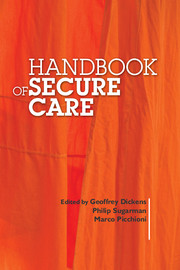Book contents
- Frontmatter
- Contents
- List of tables, boxes and figures
- List of contributors
- Preface
- 1 The evolution of secure and forensic mental healthcare
- 2 Mental disorder and offending
- 3 Clinical risk assessment in secure care
- 4 Risk management in secure care
- 5 Recovery in secure environments
- 6 Personality disorder
- 7 Women's mental health, aggression and offending
- 8 Offenders with intellectual disability in secure services and the criminal justice system
- 9 Secure mental healthcare for young people
- 10 Secure care for people with autism spectrum disorder
- 11 Acquired brain injury, trauma and aggression
- 12 Managing aggression and violence in older people
- 13 Firesetting in secure settings: theory, treatment and management
- 14 Specialist psychological treatment programmes in secure mental healthcare
- 15 Nursing in secure mental healthcare settings
- 16 Prescribing for specialist populations
- 17 Human rights in secure psychiatric care
- 18 Quality assurance and clinical audit in secure psychiatric care
- 19 Psychological support following violent assault and trauma: what works for staff in secure settings?
- Index
7 - Women's mental health, aggression and offending
Published online by Cambridge University Press: 02 January 2018
- Frontmatter
- Contents
- List of tables, boxes and figures
- List of contributors
- Preface
- 1 The evolution of secure and forensic mental healthcare
- 2 Mental disorder and offending
- 3 Clinical risk assessment in secure care
- 4 Risk management in secure care
- 5 Recovery in secure environments
- 6 Personality disorder
- 7 Women's mental health, aggression and offending
- 8 Offenders with intellectual disability in secure services and the criminal justice system
- 9 Secure mental healthcare for young people
- 10 Secure care for people with autism spectrum disorder
- 11 Acquired brain injury, trauma and aggression
- 12 Managing aggression and violence in older people
- 13 Firesetting in secure settings: theory, treatment and management
- 14 Specialist psychological treatment programmes in secure mental healthcare
- 15 Nursing in secure mental healthcare settings
- 16 Prescribing for specialist populations
- 17 Human rights in secure psychiatric care
- 18 Quality assurance and clinical audit in secure psychiatric care
- 19 Psychological support following violent assault and trauma: what works for staff in secure settings?
- Index
Summary
Introduction
This chapter explores the relationship between mental disorder and offending behaviour in women, highlighting gender differences and considering how these have shaped the evolution of secure mental health services provision for women in the UK.
Prevalence of mental disorder in women
The relationship between female gender and mental disorder is far from straightforward, influenced in part by gender-specific social and cultural factors, and in part by genetic and environmental factors relating to mental disorders in both men and women. Generally speaking, the prevalence of severe mental illnesses such as schizophrenia and bipolar disorder is unrelated to gender and is broadly similar among men and women (Abel et al, 2010; Diflorio & Jones, 2010). However, some diagnoses can only be made in women as they relate specifically to a fundamental aspect of female gender, for example, postnatal depression and postpartum psychosis. Among other psychiatric conditions that occur in both genders there is a spectrum of relative prevalence between men and women. For example, conditions such as eating disorder predominate (over 90%) among women (Smink et al, 2012). Although interest in biological factors is growing, the social context of the lives of women and girls is believed to play a significant part in explaining this finding (Herpetz-Dahlmann et al, 2011).
The prevalence of non-psychotic disorders such as depression, anxiety disorder and post-traumatic stress disorder (PTSD) is higher among women than men (Angst et al, 2002; National Comorbidity Survey, 2005). Women have a longer average lifespan than men, rendering the prevalence, but not the incidence, of conditions such as dementia more common in women as they age (Schmidt et al, 2008). A similar explanatory model has been postulated to account for the higher prevalence of depression in women (Pilgrim, 2010). Historically, substance misuse has always been less common among women than men; however, this is a trend that has gradually been reversing, raising questions about changing social influences. Finally, certain psychiatric conditions are far less prevalent among women, most notably antisocial personality disorder. It is also notable that men complete suicide more commonly and via more violent means than women. This is in contrast to the higher prevalence of self-harming behaviour in women than in men (Canetto et al, 1998).
- Type
- Chapter
- Information
- Handbook of Secure Care , pp. 99 - 112Publisher: Royal College of PsychiatristsPrint publication year: 2015



